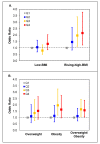Effects of Maternal Dietary Patterns during Pregnancy on Early Childhood Growth Trajectories and Obesity Risk: The CANDLE Study
- PMID: 32069778
- PMCID: PMC7071328
- DOI: 10.3390/nu12020465
Effects of Maternal Dietary Patterns during Pregnancy on Early Childhood Growth Trajectories and Obesity Risk: The CANDLE Study
Abstract
We investigated the associations between maternal dietary patterns during pregnancy and early childhood growth trajectories and overweight/obesity risk in offspring. Maternal diet was assessed using a food frequency questionnaire during the second trimester, and dietary patterns were derived by reduced rank regression. The associations between maternal dietary pattern scores and body mass index (BMI) trajectories from birth to age four (rising-high, moderate, and low BMI trajectories) as well as overweight/obesity risk at age four were analyzed (n = 1257). Two maternal dietary patterns were identified. The fast food pattern included a higher intake of fried chicken and fish, fruit juices, mayonnaise, and sugar-sweetened beverages, while the processed food pattern included a higher intake of dairy, salad dressing, processed meat, and cold breakfast cereal. Women with greater adherence to the fast food pattern were more likely to have children in the rising-high BMI trajectory group [OR (95% CI) = 1.32 (1.07-1.62); p = 0.008] or having overweight/obesity at age four [OR (95% CI) = 1.31 (1.11-1.54); p = 0.001]. The processed food pattern was not associated with these outcomes. The maternal dietary pattern during pregnancy represented by fried foods and sugar-sweetened beverages may contribute to rapid early childhood growth and increased risk for obesity in offspring.
Keywords: childhood obesity; fast food; growth trajectory; maternal dietary pattern; pregnancy.
Conflict of interest statement
The authors declare no conflict of interests.
Figures
References
-
- Fryar C.D., Carroll M.D., Ogden C.L. Prevalence of Overweight, Obesity, and Severe Obesity Among Children and Adolescents Aged 2–19 Years: United States, 1963–1965 Through 2015–2016.National Center for health statistics, September 2018. [(accessed on 12 February 2020)]; Available online: https://www.cdc.gov/nchs/data/hestat/obesity_child_15_16/obesity_child_1....


